Description
According to a pattern inspired by Albrecht Dürer's prints, Lotto placed St. Nicholas in the upper center, with a luminous halo crowning his face. The saint is looking upwards, suggesting that he is ascending, and is surrounded by three angels who keep his mantle open and hold his traditional symbols: the mitre, the episcopal crozier and three golden balls, in memory of the three maidens saved by Nicholas according to the legend.
Below him are St. John the Baptist (patron of one of the donors) and St. Lucy, whose tooth is alleged to have been preserved in the church as a holy relic.
The lower part is occupied by a dark landscape, featuring, amongst other details, a sea harbor and a port struck by a storm. The style of this section shows the influence of the Danube school. The small scene of St. George killing the dragon was added to fulfill one of the donor's wishes.

An altarpiece is an work of art in painting, sculpture or relief representing a religious subject made for placing at the back of or behind the altar of a Christian church. Though most commonly used for a single work of art such as a painting or sculpture, or a set of them, the word can also be used of the whole ensemble behind an altar, otherwise known as a reredos, including what is often an elaborate frame for the central image or images. Altarpieces were one of the most important products of Christian art especially from the late Middle Ages to the era of Baroque painting.

Lorenzo Lotto was an Italian painter, draughtsman, and illustrator, traditionally placed in the Venetian school, though much of his career was spent in other north Italian cities. He painted mainly altarpieces, religious subjects and portraits. He was active during the High Renaissance and the first half of the Mannerist period, but his work maintained a generally similar High Renaissance style throughout his career, although his nervous and eccentric posings and distortions represented a transitional stage to the Florentine and Roman Mannerists.

Vittore Carpaccio (UK: /kɑːrˈpætʃ oʊ/, US: /-ˈpɑːtʃ-/, Italian: [vitˈtoːre karˈpattʃo]; was an Italian painter of the Venetian school who studied under Gentile Bellini. Carpaccio was largely influenced by the style of the early Italian Renaissance painter Antonello da Messina, as well as Early Netherlandish painting. Although often compared to his mentor Gentile Bellini, Vittore Carpaccio's command of perspective, precise attention to architectural detail, themes of death, and use of bold color differentiated him from other Italian Renaissance artists. Many of his works display the religious themes and cross-cultural elements of art at the time; his portrayal of St. Augustine in His Study from 1502, reflects the popularity of collecting "exotic" and highly desired objects from different cultures.

BartolomeoMontagna was an Italian Renaissance painter who mainly worked in Vicenza. He also produced works in Venice, Verona, and Padua. He is most famous for his many Madonnas and his works are known for their soft figures and depiction of eccentric marble architecture. He is considered to be heavily influenced by Giovanni Bellini, in whose workshop he might have worked around 1470. Benedetto Montagna, a productive engraver, was his son and pupil and active until about 1540. He was mentioned in Vasari's Lives as a student of Andrea Mantegna but this is widely contested by art historians.

Alessandro Bonvicino, more commonly known as Moretto, or in Italian Il Moretto da Brescia, was an Italian Renaissance painter from Brescia, where he also mostly worked. His dated works span the period from 1524 to 1554, but he was already described as a master in 1516. He was mainly a painter of altarpieces that tend towards sedateness, mostly for churches in and around Brescia, but also in Bergamo, Milan, Verona, and Asola; many remain in the churches they were painted for. The majority of these are on canvas, but a considerable number, including some large pieces, are created on wood panels. There are only a few surviving drawings from the artist.

Giovanni Battista Cima, also called Cima da Conegliano, was an Italian Renaissance painter, who mostly worked in Venice. He can be considered part of the Venetian school, though he was also influenced by Antonello da Messina, in the emphasis he gives to landscape backgrounds and the tranquil atmosphere of his works.

Giovanni Girolamo Savoldo, also called Girolamo da Brescia, was an Italian High Renaissance painter active mostly in Venice, although he also worked in other cities in northern Italy. He is noted for his subtle use of color and chiaroscuro, and for the sober realism of his works, which are mostly religious subjects, with a few portraits. His portraits are given interest by their accessories or settings; "some even look like extracts from larger narratives".

Sebastiano Ricci was an Italian painter of the late Baroque school of Venice. About the same age as Piazzetta, and an elder contemporary of Tiepolo, he represents a late version of the vigorous and luminous Cortonesque style of grand manner fresco painting.

Giovanni Cariani, also known as Giovanni Busi or Il Cariani, was an Italian painter of the high-Renaissance, active in Venice and the Venetian mainland, including Bergamo, thought to be his native city.
The decade of the 1480s in art involved some significant events.
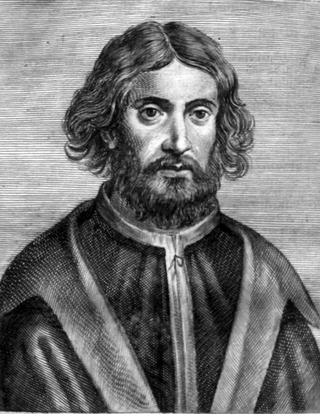
Palma Vecchio, born Jacopo Palma, also known as Jacopo Negretti, was a Venetian painter of the Italian High Renaissance. He is called Palma Vecchio in English and Palma il Vecchio in Italian to distinguish him from Palma il Giovane, his great-nephew, who was also a painter.

The Altarpiece of the Halberd is an oil-on-canvas painting created ca.1539 by the Italian High Renaissance painter Lorenzo Lotto. It is housed in the Pinacoteca civica Francesco Podesti of Ancona, central Italy.

The Martinengo Altarpiece is a painting by the Italian High Renaissance painter Lorenzo Lotto, finished in 1516. It is housed in the church of Santi Bartolomeo e Stefano in Bergamo in northern Italy.
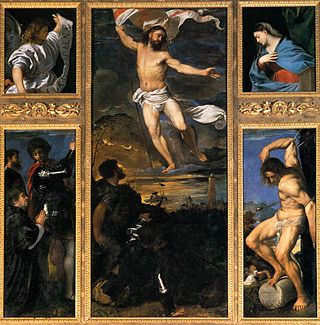
The Averoldi Polyptych, also known as the Averoldi Altarpiece, is a painting by the Italian Renaissance painter Titian, dating to 1520–1522, in the basilica church of Santi Nazaro e Celso in Brescia, northern Italy.
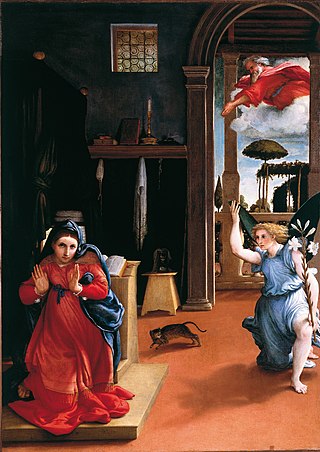
The Recanati Annunciation is an oil-on-canvas painting by the Italian Renaissance painter Lorenzo Lotto, executed around 1534 and housed in the Civic Museum of Villa Colloredo Mels, Recanati, Italy.

The San Giacomo dell'Orio Altarpiece (or Madonna and Four Saints) is an oil-on-canvas painting by the Italian High Renaissance artist Lorenzo Lotto, dating from 1546 and housed in the church of San Giacomo dell'Orio in Venice. It is signed and dated on the cartouche hanging at the throne's base, reading "In tempo de Maistro Defendi de Federigo et compagni 1546 Lor. Lot". The canvas is one of the last works executed by Lotto in Venice before he relocated to the Marche.

The Crucifixion with Pietà or Crucifixion is a painting by the Italian Renaissance painter Lorenzo Lotto, executed in 1529–1534 and housed in the church of Santa Maria della Pietà in Telusiano, Monte San Giusto, province of Macerata, region of Marche, Italy.

St Antoninus Giving Alms or The Alms of St Antoninus is an oil-on-canvas painting by the Italian artist Lorenzo Lotto, created c. 1540–1542. It depicts Archbishop Antoninus of Florence giving alms as an allegorical ideal for bureaucratic charity. The painting is now displayed in the Basilica dei Santi Giovanni e Paolo in Venice.
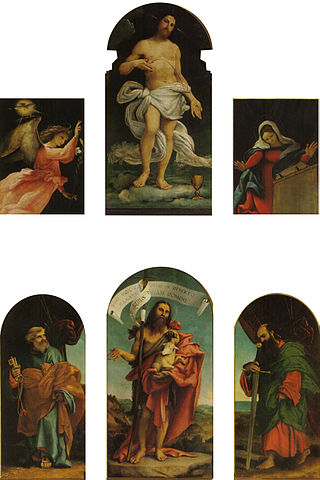
The Ponteranica Altarpiece is a six-panel oil painting series produced by Lorenzo Lotto in 1522, commissioned by the Scuola del Corpo di Cristo for the parish church of San Vincenzo e Sant'Alessandro in Ponteranica, where it still remains. Its upper register shows the risen Christ flanked by an Annunciation scene, whilst below is John the Baptist flanked by saints Peter and Paul.
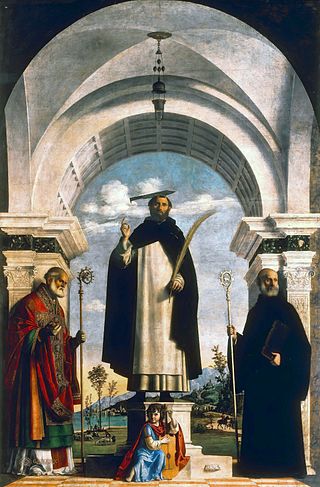
St Peter Martyr with St Nicholas and St Benedict is an oil-on-canvas painting by the Italian Renaissance painter Cima da Conegliano, created c. 1505–1506, now in the Pinacoteca di Brera in Milan. It references the sacra conversazione pieces by Giovanni Bellini, whilst the landscape shows the artist as an early adopter of the new style of Giorgione.



















